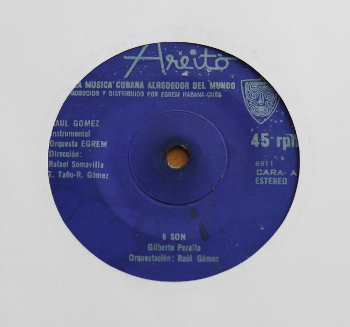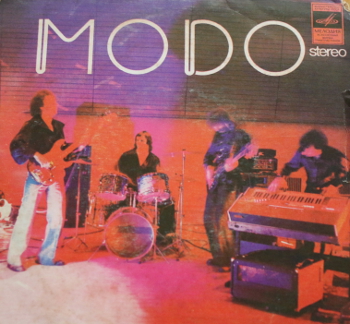It’s been a lifelong dream of mine to go to Cuba, and this Summer I was finally able to make that dream a reality. Though there are many reasons that I’ve wanted to make this trip, one of the biggest is, unsurprisingly, the music. One of the consequences of the U.S. embargo has been that post-revolutionary music from Cuba is excpetionally difficult to find in the States. Your best chance is to find them online, generally from dealers based in Japan, Russia or Canada. But I’d long wanted to dig at the source and the time has come to share with you all some of the discoveries I made down there.
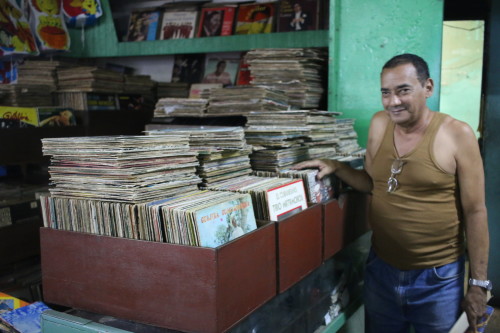 This first trip down I focused on one of the few vinyl shops in Havana, a place that Gilles Peterson and Questlove have made famous, Tienda Seriosha in Habana Central. From what I had read before, I thought that the store was just a record store, but it’s shared space with a number of vendors (including someone at the front selling CDs, most of which seemed to be mixes). The records are towards the back, tucked away in the corner and though they don’t take up a lot of space, they’re really packed in. I spent the better part of two days at Seriosha, focusing one day on 12″ and the other on 45s. On both counts, I got through only 1/2 of the records that were there, but had to stop, not only because the store closed at 5pm, but also because the piles of stuff I was pulling out were far to big for the money I had with me. The main man at the store, Rafael (pictured above) was kind enough to set aside the small mountain of records I’d dug up until I finally made full decisions, on the third day. LPs at Seriosha are $5 and 45s are $2, regardless of the title or the condition, so I was able to take home a tidy haul of records, increasing the Cuban section of my collection by roughly 1500%, with 95% of those records being things that I had never even heard.
This first trip down I focused on one of the few vinyl shops in Havana, a place that Gilles Peterson and Questlove have made famous, Tienda Seriosha in Habana Central. From what I had read before, I thought that the store was just a record store, but it’s shared space with a number of vendors (including someone at the front selling CDs, most of which seemed to be mixes). The records are towards the back, tucked away in the corner and though they don’t take up a lot of space, they’re really packed in. I spent the better part of two days at Seriosha, focusing one day on 12″ and the other on 45s. On both counts, I got through only 1/2 of the records that were there, but had to stop, not only because the store closed at 5pm, but also because the piles of stuff I was pulling out were far to big for the money I had with me. The main man at the store, Rafael (pictured above) was kind enough to set aside the small mountain of records I’d dug up until I finally made full decisions, on the third day. LPs at Seriosha are $5 and 45s are $2, regardless of the title or the condition, so I was able to take home a tidy haul of records, increasing the Cuban section of my collection by roughly 1500%, with 95% of those records being things that I had never even heard.
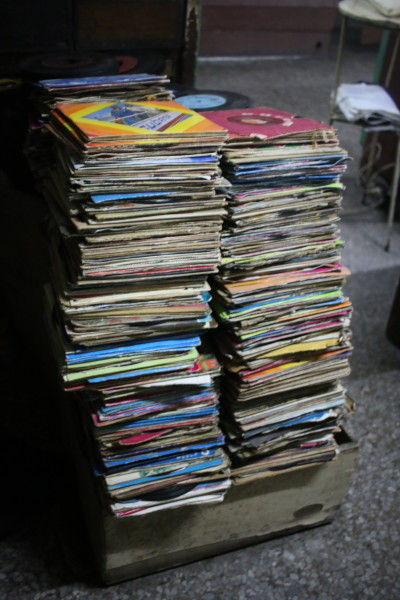 Like a number of people, the Si, Para Usted collections put out by Waxing Deep were an introduction to the 1960s-1970s revolutionary period of Cuban music. Prior to that, the only group I’d heard about was Irakere, and even then, only the music they recorded in the 1980s. I tried to use what I’d learned from those collections and the few records that I had (which I’ve featured here, from Juan Pablo Torres and Mirta y Raul) in making my decisions on what to buy and what to leave behind. In most cases I looked for particular artists or bands, or particular rhythms that I knew were associated with the kind of music I enjoy the most (thankfully most Cuban records will list the rhythm for many of the individual songs). As thankful as I am for the experience of being able to dig at Seriosha’s, I’m haunted by those records left behind. But this is likely only the first trip of what will become a fairly regular experience for me (I’m already planning trip #2, which hopefully will happen next Spring).
Like a number of people, the Si, Para Usted collections put out by Waxing Deep were an introduction to the 1960s-1970s revolutionary period of Cuban music. Prior to that, the only group I’d heard about was Irakere, and even then, only the music they recorded in the 1980s. I tried to use what I’d learned from those collections and the few records that I had (which I’ve featured here, from Juan Pablo Torres and Mirta y Raul) in making my decisions on what to buy and what to leave behind. In most cases I looked for particular artists or bands, or particular rhythms that I knew were associated with the kind of music I enjoy the most (thankfully most Cuban records will list the rhythm for many of the individual songs). As thankful as I am for the experience of being able to dig at Seriosha’s, I’m haunted by those records left behind. But this is likely only the first trip of what will become a fairly regular experience for me (I’m already planning trip #2, which hopefully will happen next Spring).
When I returned back home, I spent another day cleaning up all of the records. Aside from dust and smoke, many of the records had heat damage (which is to be expected, since it can get brutally hot in Cuba…I now know this first hand having gone in August when the heat is at its hottest), so not all of them are pristine in terms of their condition, but as you can tell from this blog, I’m not a purist when it comes to the condition, it’s the music that’s most important. These are just a few of my favorite 45s that I dug up at Seriosha’s. There was so much quality that I’m going to be posting 2 different mixes, one focused on 45s, the other on LPs, over the next couple of weeks. Even though I brought back more records than I’ve bought at a single time, there’s still so much to discover from the 1960s-1980s in Cuban music. This really is just a taste…
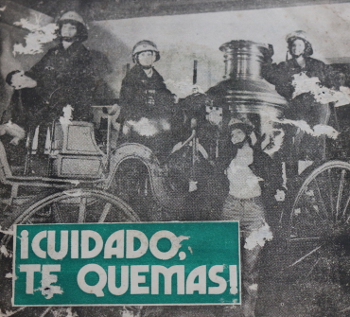
Conjunto Los Latinos – Quemando
I know you’re not supposed to judge a record by its cover, but honestly, this cover was so cool, it wouldn’t have mattered what the music sounded like. Turns out, just like the cover (which essentially translates to “Watch Out, You’re Burning!”) each of three songs, from Los Latinos, Son 14 and Roberto Faz, are fire related. Of the bunch, “Quemando” is my favorite, and one of my favorite songs that I tracked down in Cuba. It is also featured on an LP Los Latinos put out, and that was there, but the condition on that one just didn’t seem like it could be salvaged. Given that, I was extremely happy that I found this song here and that it does burn, just as advertised.
Raul Gomez’s Instrumental album from the late 1970s was one of the records that was on my list that I had hoped to track down while in Cuba (I also hoped to find that Grupo Los Yoyi album, but not this time). I didn’t find his record, but I did track down a couple of 45s that featured songs from it (one of which features a VERY Barry White inspired tune called “Anatomia De Un Problema”). “6 Son” is emblematic of the late 1970s period of Cuban big band music, taking aspects of disco and psychedelic music into something truly unique.
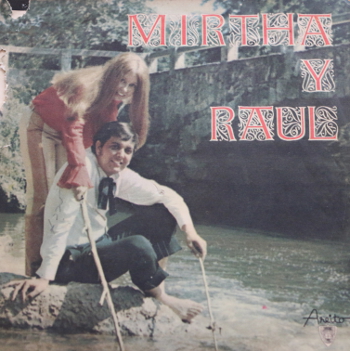
Mirta y Raul – Salvaje Del Amor Pierde La Felicidad
Almost a decade before “6 Son” Raul Gomez was one half of what might be described as Cuba’s “Sonny & Cher,” along with Mirta Medina…Mirta y Raul. As I’ve previously mentioned here, I love the sound that Mirta y Raul put together, backed up by Los Bucaneros. I found two 45s from that album, including this one that features one of my favorite tunes, “El Sueno Del Andria.” What I didn’t realize until I got home and got a chance to compare these 45s to the album was that there were some non-LP tracks on each. “El Salvaje Del Amor Pierde La Felicidad” is as good as anything that made it onto the LP (“Andria” notwithstanding), psychedelic 60s beat sound that has a nice hard groove. Was looking forward to dropping this into my most recent set at Funky Sole, but couldn’t find the right place…perhaps next time.
One of the things I was really interested to see was what kinds of records there might be in Cuba from other countries. I had hoped I’d run into some things from other Latin American countries or for the former Soviet Union, and in this case hit pay dirt. From the look of the cover, you’d expect Modo to be a progressive rock group, and the A side confirms this, with a proggy instrumental. But when I flipped the 45 over and dropped the needle on the two tracks there, I was gobsmacked by the sound coming out of the speakers. The band had transformed into a pretty tight 1970s funk outfit, with some vocalists. “Ziedu Karalis” I spun at Funky Sole, where it was received in a most welcome fashion. “Navajag Raudat” isn’t necessarily for the dancefloor, but those drums at the start are super dirty. Nothing spreads joy to the face of a DJ quite like a clean drum break from a source you never would have guessed.
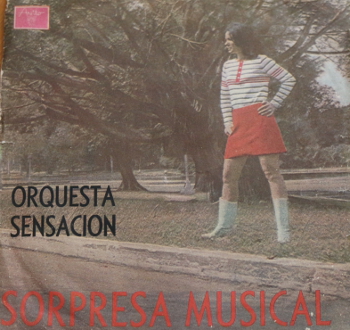
Orquesta Sensacion – Shake De Amor
The #1 area of Cuban music that I realized that I know the least about is the mid-sixties. During this time Cuban bands started to add rock and soul rhythms to their music, in much the same way Latin groups did during the heyday of Boogaloo in NYC. The hand clap intro to Orquesta Sensacion’s “Shake De Amor” gives you the sense that this track would have fit in nicely in that scene, but as is the case with so much Cuban music, the band takes the rhythm in places that few other musicians would. It’s the distinctiveness of this sound, something that seems to be a hallmark of Cuban musicians, to have your own style, that I love and that’s the thing that will keep me coming back to search for more musical surprises in the coming years.
Cheers,
Michael


